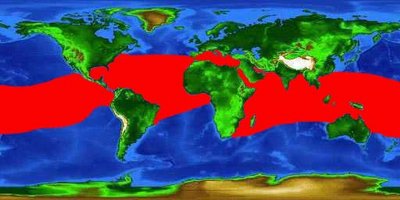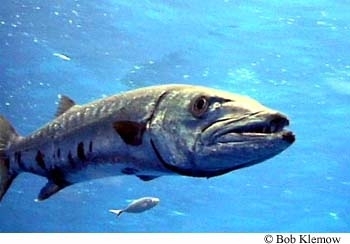Great barracuda (About the EoE)
Contents
Great barracuda
The Great barracuda (Sphyraena barracuda) is a large predatory fish in the Family Sphraenidae that is found worldwide in tropical waters.
 Great barracuda. © 2004-08 Florent Charpin Great barracuda. © 2004-08 Florent Charpin |
|
Kingdom: Animalia (Animals) |
Physical Description
Great barracudas are long (0.45 to 2.00 meters) silvery fish, with large scales, and may grow to 50 kilograms in body mass. The species pointed head ends in a large mouth that contains two rows of knife-like teeth. The lower jaw projects beyond the upper jaw, which feature is helpful in biting.
They are a grayish brown above and silvery below, which color combination is quite universal throughout the geographic range. They often have dark ink-like spots that are arranged in no particular pattern on their sides. The young have dark crossbars on their backs and blotches on their sides. The young also have a soft dorsal fin, with anal and caudal fins manifesting as blackish. Males and females are superficially indistinguishable to humans.
Distribution
 Distribution of the Great barracuda. Florida Museum of Natural History.
Distribution of the Great barracuda. Florida Museum of Natural History. This species is almost always found in warm seas. In the Indo-Pacific they are found in the Red Sea, and from the east coast of Africa to Hawaii and the Marquesan and Tuamoto Islands. In the Western Atlantic they are occur from Massachusetts (USA) and Bermuda throughout the Caribbean Sea to Brazil. In the Eastern Atlantic they occur in Sierra Leone, Côte d'Ivoire, Togo, Nigeria, Senegal, Mauritania, St. Paul's Rocks, and São Tomé Island.
Habitat
Adult Great barracudas live in and around the edges of coral reefs at depths ranging from one to 100 meters, most commonly between three and 30 meters. They tend to avoid brackish water unless they are getting ready to spawn. Juveniles occur among mangroves, estuaries and shallow sheltered inner reef areas. When adults attain a large enough stature to protect themselves, they move out into the open ocean and then to the margins of the coral reefs.
Feeding Behavior
Great barracuda chiefly consume fish, but they also feed on cephalopods and shrimp. Their large teeth are quite useful for capturing fish prey (Predation). They have a large gape which allows them to feed on extremely large fish by chopping them in half. They devour what they can catch using their combination of a sit-in-wait and active predator style. Their narrow head-on profile and silvery color reduces their visibility to prey. They feed on both Bottom:dwelling species as well as species of the higher water column. They rely on their acute vision to locate prey. Great barracudas may herd schools of fish into shallow water and guard them until their previous meal has been digested, and they are hungry again.
Behavior
S.barracuda is usually a solitary fish in its adult phase, especially at night. Juveniles and adults may form groups during the day, sometimes containing hundreds, or even thousands, of individuals.
Great barracudas are inquisitive and may follow divers or snorkelers. However, attacks by barracudas on humans are very rare, and may most often occur when the fish attempt to take food from spear fishers .
Reproduction
It is still unclear about the timing and location of spawning of the Great barracuda. In fact, great barracudas appear to show different spawning patterns in different areas of the world. They typically spawn in shallow waters such as estuaries. Great barracuda do not care for their fertilized eggs, which drift out into the ocean, and after hatching the larvae enter the planktonic stage. The larvae settle in shallow areas on the margins of clear-water estuaries. When the larvae reach about 30 centimeters they move to open waters and eventually they move out of the estuaries completely when they reach about half a meter in length. They reach sexual maturity at 60 centimeters and may live for about 14 years.
Associations
As juveniles, these fish compete for food supplies with needlefishes and small snapper. This competition consists of killifishes, herrings, sardines, gobies, silversides, anchovies small mullets, and lizardfishes to name a few. As the fish get older and bigger, they may compete with larger fish like mackerel, or even dolphins, depending on their habitat.
The Great barracuda may be parasitized by fish, such as remoras or pilotfish, that attach to their bodies and use them as a source of propulsion.
Conservation Status
The Great barracuda is not listed as a threatened or endangered species.
Further Reading
- Encyclopedia of Life. 2011. Sphyraena barracuda (Edwards, 1771)
- Marinebio. 2011. Sphyraena barracuda Great Barracuda
- University of Florida. 2011, Great Barracuda
- Humann, P. and N. Deloach (Editor), 1994. Reef Fish Identification: Florida, Caribbean, Bahamas. New World Publications, Inc. Jacksonville, FL. ISBN: 1878348078
- Deloach, N. 1999. Reef Fish Behavior, Florida, Caribbean, Bahamas. New World Publications, Inc. Jacksonville, FL. ISBN: 1878348280
